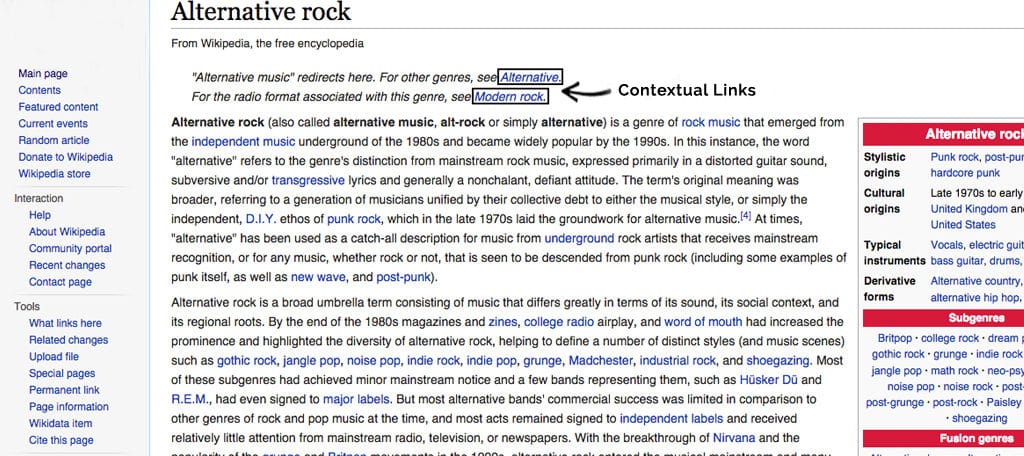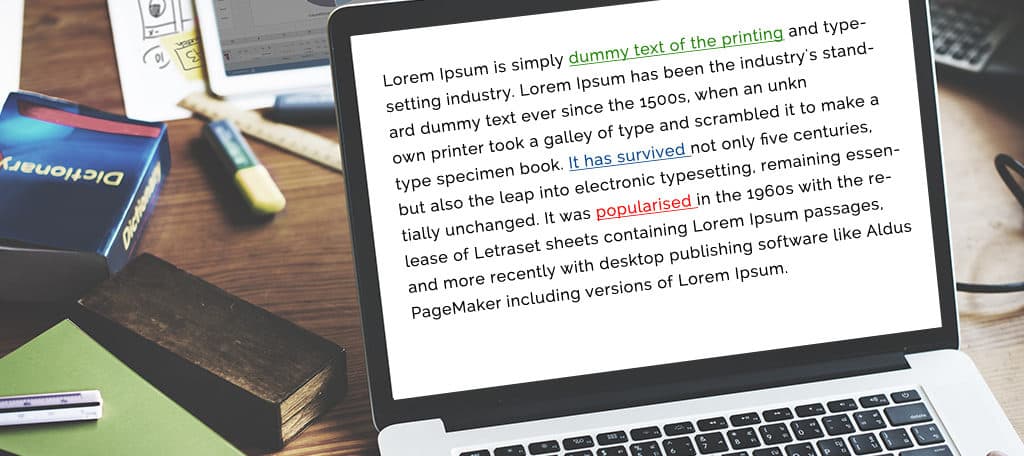
Part of enhancing the website’s appearance on search engines is by having relevant links pointed at your content. These are commonly called “backlinks.”
As important of a role as these could play, the content linking within your site is also a significant factor. Internal linking not only gives visitors a chance to explore other pages on your site, but it will also influence how search engines crawl and categorize your material.
Here are the 10 best kept secrets about how these links work to improve optimization on your website.
1. Lots of Content

One of the most important aspects to creating internal links is having the content to link to in the first place.
Many experts hold this aspect in high regard as creating lots of material simply gives your site more for which to create relevant internal links.
The more content you create, the better are the chances for developing quality pieces that stand out. Before you start implementing internal connections, you’ll need to establish a strong content strategy.
This can be used to enhance the potential for quality internal linking.
2. Linking to the Most Important Content from the Homepage

Linking to the most important and popular content from the homepage is beneficial for both visitors and SEO. As some of your traffic will be visiting the site by its domain name, having these links in plain sight encourages exploration.
These popular and relevant pages can be found in tools such as Google Analytics. The areas that have the most visits and the longest average duration are good choices for linking in this manner.
3. Contextual Links

In most cases, links that are placed within text perform better than those that stand alone. This is because the links are surrounded by contextual material. It helps gauge the relevance of the anchor as the content before and after the link is crawled by search engines.
Whether it’s keywords or links, relevancy is the most important to keep in mind.
Google implemented contextual tracking in order to reduce the amount of spam that is displayed in search results. Because of this, your links need to be relevant to the topic if you want them to score well.
4. Add Links in Moderation
Each time you create a link to other content on your site, you’re lending out that webpage’s authority level. This means that the first page could seem less relevant in terms of search engine optimization.
Since each link taps into that authority, you want to keep them to a low level. In this case, too much of a good thing could be bad.
From a visual standpoint, too many links could also distract the visitor. Most people looking for quality content want a clean presence. In a page filled with links, an individual could get confused or otherwise have a hard time reading the content.
5. Authority of One

Some experts use a multitude of lesser pages to send links to the more important piece. This helps enhance that page’s authority when it comes to search relevance.
Not only does this create a logical path for visitors, but it also creates something search engines can crawl.
For example: Perhaps you want to give a single page as much authority in search engines as possible. You would want to start by writing new pieces that are relevant to that single page. Once you link from the new pieces to that single page, the authority of it begins to increase.
6. Sharing the Spotlight

Some experts believe linking from a popular page to one that is performing lower is a great way to share authority and enhance the lesser article. For instance, a link going from a webpage that receives 100 views per day to one that has one or two per month could increase that second page’s exposure.
This is for both the human element as well as search engines.
This works exceptionally well if you have content that is buried deep within your site. Search engines will only crawl so far in the hierarchy of webpages. Prompting the bots to crawl those lesser pages from the popular ones may help indexing.
7. Adding Value

The internal links you create should be based in value to the reader. For example, a link pointing to a more detailed explanation of a topic that was only briefly described is ideal.
Essentially, you want to give your readers something to follow that has potential to add value to the content.
Search engines, such as Google, are focused more on quality than quantity. Many of the algorithms they use are reminiscent to how a human visitor explores the website.
Instead of focusing on getting the search engine to crawl certain pages, create them as if the bot was a real person. Guide it to the content that is relevant to the topic at hand.
8. The Natural Flow

The links you create need to have a natural flow from one page to another. There needs to be a seamless transition from the first page into the next. It’s much like linking together chapters of a book.
If you were to link chapter one to chapter ten, your readers would be missing a large chunk of the plot.
Each consecutive link should lead a visitor from one logical thought to another. Keeping the flow of material going could keep a person engaged while increasing the likelihood of exploring the website further.
You don’t want your links to look haphazard or scattered.
9. The Right Anchor Text

The anchor is the actual text that is being used as a link. This can be quite tricky to figure out in whole. There are a variety of methods you could use depending on the development of your site.
Many people will rely on generic anchors such as “click here” and “read more.”
One thing you want to be wary of is matching links to keywords. In some instances, Google may penalize the site because of this practice. For example, you wouldn’t want your anchor to be “golfing” if the keyword you’re using is the same.
10. Color Can Matter

Some experts attest how color influences whether or not a visitor clicks an internal link. It needs to be obvious in order to inspire people to use it, and you don’t want it to resemble your regular text too closely.
If it’s difficult to tell whether or not it’s a link, people may assume it’s not.
Search engines really don’t care about the color of the link. From a crawling perspective, any color is just as good as another. It’s actual relevancy that sites like Google and Bing are looking for.
Expand Your Links
Internal linking is one of the easiest methods to boost SEO. Although it could seem tedious, it’s a worthwhile investment of your time. With each new piece of content, try to keep past posts in mind that may be relevant to what you’re currently writing.
You could quickly add the link giving both webpages greater purpose. Just make sure you don’t over do it. Too many links could have a detrimental effect on SEO.

Hi there,
I’m so glad to read that ‘adding value’ is one of your top ten. While SEO is incredibly important for businesses to succeed online, (I am an SEO myself), I feel like so many online marketers miss the point. And that is to add value to users.
Thank you!
One thing I like to do when creating content is to add to the user experience by embedding interactive elements on the webpage. It helps with keeping the user longer on your site and it adds value to the user because they can interact with the content in a way that makes sense to them.
Very good advices, i didn’t know about anchor text and natural flow. This helps me a lot. Thanks.
SEO is intergral part of any website, and this is for the first time I am reading about Colored links can influence SEO strategy. Backlinks are not much of importance now a days than they used to be in the past but they still plays a big role to get website higher in SERP.
Thanks for sharing an awesome post. Especially I love the “Contextual Links” part. From the SEO point of view, contextual links or the using the relevant links with the proper keyword plays a major role when it comes to website ranking.
Thanks for sharing this great post. Clearly explained in a well designed step by step manner.
Hey,
I just preformed your tips on a client site and as a result it has took a real boost!
Thanks!
Hi Joe,
I’m glad that one of our articles was able to help you make an impact for your client!
thanks for the post. All of the points you mentioned may work for affiliate site, but do you think it will work for local sites (sites in the local area like local businesses?)
Hi Ganesh,
While there are differences for local SEO, internal linking of relevant pages is still beneficial to your websites overall optimization.
Great post! I agree with most of the points but in regards to your point number 10 which is about colours I disagree.
Hi Serglos,
Why is it that you disagree?
I also agree that adding value is one of the more important things you can do for SEO. This would probably be considered helping “human” visitors more than bots, and it is. But that is very important as well–especially for conversion purposes and keeping the visitor interested. Bots are always getting smarter programming too. There may come a time when they can tell the difference between content for the sake of ranking versus content that adds true value.
Anchor text is also a very important aspect of SEO that is often misunderstood. I’m glad to see that you mention how it is not a good practice to link with too much keyword anchor text. A little of that goes a long way and can indeed get you penalized.
nice article green geeks. quality content creation (not unlike your topic here) is one of our biggest challenges internally and for our clients. we generally link back to the page we want to rank and especially when you share it socially it should always have a link back.
Great article. It’s nice to know how internal linking boost up our sites and the importance of linking to the important pages on our websites. I also liked the moderation aspect very much. Thanks.
Good point at #3 – we find that most people overlook the fact that there is the necessity for relevancy. We’re finding it more and more important as we go along.
Nice to see you have made reference to keyword anchor text when linking internally for SEO. Its very easy to get an over-optimisation penalty from internal linking with keyword matched anchors. Best to use long-tail anchors so you can have a tone of variance over time.
Thanks for such a clear and comprehensive post. I agree that “the most important content to be linked from the home page” is very important. Our readers want to get to the – good stuff – fast, so once they land on my site I will direct them via links into my inner pages.
You hit the nail on the head with natural flow. SEO has been given a bad name with all the spam and black hat tactics along with it. I find giving free value in your content is the best way to get natural attention and back links. If people enjoy the content you are publishing they are likely to share and follow your work.
Using keyword anchor text can (and is) really helpful. As you mentioned, Google does give penalties for over-optimizing keywords. We’ve found it best to mix in both, some keyword anchors and some generic anchor texts.
I also totally agree with Johleen about the “adding value” comment. There is just so much crap out there these days – which will sooner or later be weeded out the more Google (and other search engines) keep updating their algorithms to focus on value and relevance, rather then quantity of links etc…
Nice article! Cheers
Nice article and so practically useful too. I found the natural flow and context points struck a cord with me, even though the rest were just as useful. Its an education to see that all this can be done in a natural and helpful way for SEO benefit instead of trying to game the system. So helpful – thanks.
A lot of people go crazy with the anchor text. No matter what you do with SEO, they need to realize that you should do what is going to be natural to Google. It’s why just shooting out links left and right will get you deindexed very quickly, and with the same keywords over and over again.
Well said Johleen, adding value with original content is key and should not be under estimated as Google just wants to display the most relevant and credible results to it’s users.
I did not know about the sharing spotlight trick. This could be something that I can use on my client’s website. He has lots of pages that do not get crawled by the search engine.
Google looks at the internal links and recognize the value being shared. If you think about Wikipedia, they share an enormous amount of internal links, not for spamming reasons but because they have so many pages and all of them provide informational value. For SEO, this is the same concept we want embrace. On top of that, it’s all natural looking. Thanks for the great share.
Wow, thank you! I never knew that internal linking could be that effective for SEO. It’s always been the do-follows and no-follows in my vocabulary. Hopefully my SEO methods would improve.
Internal links definitely help! For sure add this to your to-do list.
#4 is especially true. I almost lost my site because I added too many links too quickly
Hi Anna, I find so much info on external linkbuilding, but few people ever go into detail about internal linkbuilding, and as you say, it’s one of the easiest (and cheapest) methods to boost SEO.
In your opinion, is it safe to use more targeted keywords in the anchor text of internal links or could that hurt a site as pertains to ranking?
The best practice is to link to relevant pages within your site and using text that best describes the linked page.
I very much agree on your points on linking in moderation, fewer quality links is better than lots of low quality ones
Very good post. I like point number 6 about linking from internal page with traffic to other pages to encourage further reading. You also state this can help index pages. If that is a problem you can always fetch as google bot in search console to have Google come crawl your site. That will encourage Google to crawl more pages than from it’s standard crawling process.
Great post Anna! Internal link is one of the ranking in SEO.
Great post.
Point 7 – Adding Value. This one seems to be where some SEOs fall over. At the end of the day we need to be building websites that cater for customers and visitors so having a value packed website is critical!
Hi Nathan, for sure. Creating content that actually answers questions is the key to ensuring Google loves your content and rewards you for it.
I very much appreciate the insight. It’s going to be helpful to me and many others. Do you have any other sources for me to read further and to be able to dig a little deeper?
I wish I saw this article earlier. Very sound advice. Besides linking to the most important content off the home page I would also consider interlinking. This can really optimize the amount of link juice that flows in between your pages.
Hi Steve, I’m glad you enjoyed the article.
Good insight about providing good content to the reader, proper use of anchor text and give value without spammy links. Thanks.
Glad you enjoyed the article!
Thanks for the tips!! Very helpful
No problem Edgar, glad you found it useful!
Hey..thanks for your thoughtful experience that you share it about internal linking.I am new in SEO.But reading your blog its make me easier to build internal linking.Some points are too good.Specially links need to be relevant to the topic,create links should be natural flow from one page to another and too many links could also distract the visitor.
Hello Sharmin,
I’m glad that our article on internal linking helped you out!
This is gold. I appreciate the insights of this article, there are too much to learn about SEO. These internal links are usually overlooked but so important.
Hi Nathan, I’m glad to hear that you enjoyed the article.
Great article man i am new in SEO and looking for link building Secrets and i thins its perfect for me. Thanks alot.
Hi! Welcome to the world of SEO. I’m glad you enjoyed our article.
Thanks for writing this article. Really it is a good stuff
Hello Sumit. Thank you. I’m glad you enjoyed our article!
Thank you for this article! I’m a silent reader of blogs but I just can’t help to thank you for creating this article. I tried to use this to one of my clients and it results to a quick boost! I will surely recommend this to my friends to read this. Cheers and more power!
Hi Mark,
Glad you enjoyed this article and that it helped one of your clients!
yes it right as you mention interlinking is so important for google bot and user to search relevant constant on website.Thanks mate good job keep it up!
Hi,
It’s definitely important, but it must make sense when you’re interlinking. Keep “usefulness” in mind when linking to other pages, internally or externally!
Thanks Kaumil. Internal links keep the users in the website and increases the session time, which has a great impact in my experience.
Hi Anna,
thank you for this great contribution!Do you always do this manually or are there also special plugins for wordpress sites, for example?
Best regards
Noah